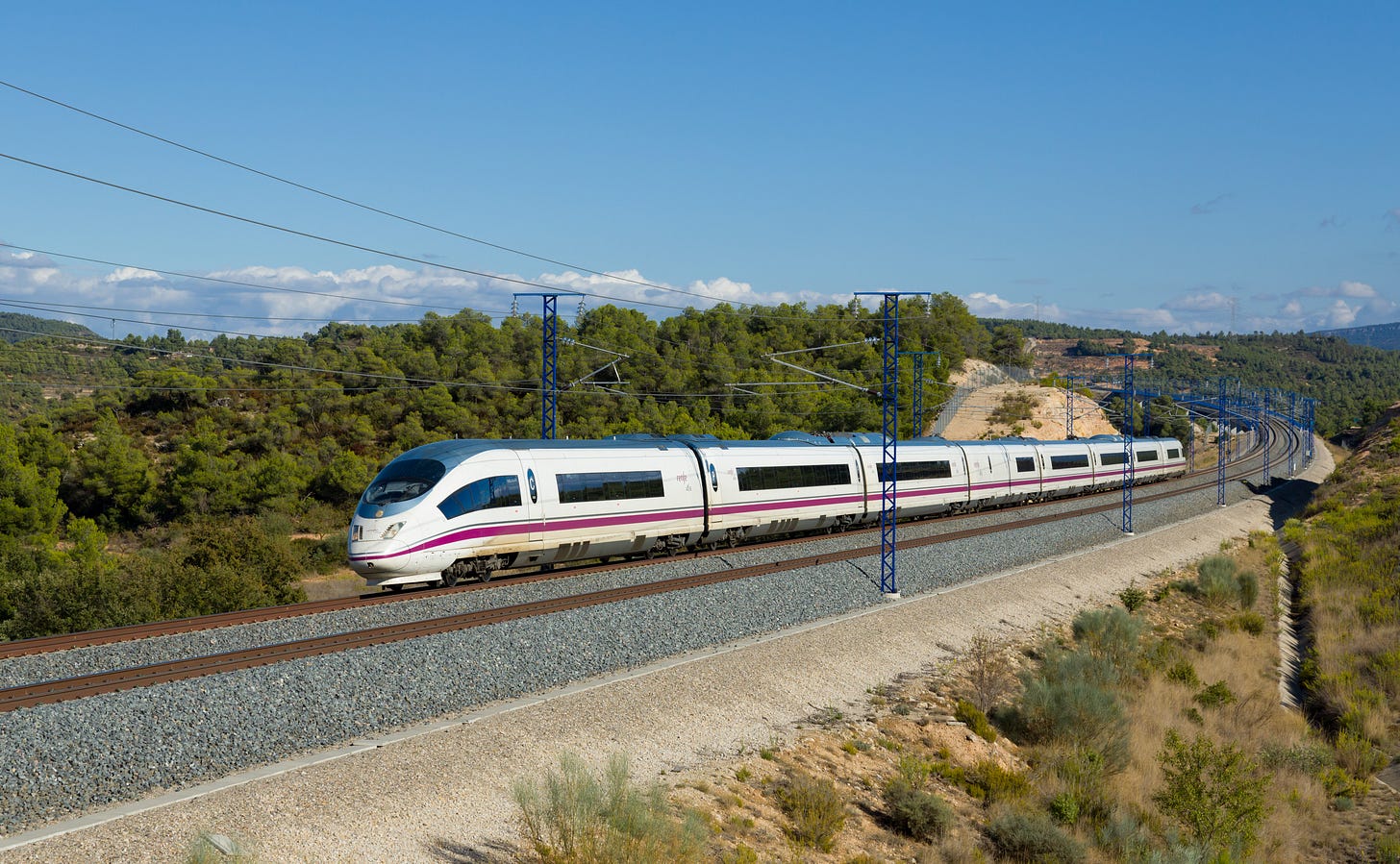The 10 fastest train routes in Europe right now

Europe’s fastest train routes show where the continent actually delivers world-class high-speed rail — not in headline design speeds, but in the real average speeds passengers experience in the timetable. This list is a snapshot based on a set of strict, but not exhaustive, criteria: city-centre to city-centre distances, the fastest scheduled non-stop services, and publicly available rail kilometres. It illustrates a top tier of high-speed performance rather than claiming to capture every possible contender.
Maximum line speeds of 300–350 km/h matter far less than the sustained speeds that can be kept between major cities. Geometry, stop patterns, traffic management and infrastructure separation determine what passengers actually experience. Based on current timetables, Spain, France and Italy dominate the upper end of the ranking — while Germany is absent due to mixed-traffic constraints.
Europe’s 10 fastest train routes today:
No. 10 — Madrid–Málaga (Spain)
Average speed: ~154 km/h | Travel time: 2:42 (≈416 km)
Spain’s southern high-speed corridor covers long distances at high speed, but connection patterns and gradients through central Spain bring the overall average down. It remains a robust performer — but other Spanish and French routes achieve significantly higher sustained speeds.
No. 9 — Paris–Lyon (France)
Average speed: ~208 km/h | Travel time: 1:53 (≈391 km)
One of Europe’s busiest long-distance corridors, the Paris–Lyon axis set early records for sustained high-speed operation. Today’s fastest services run just under two hours, constrained mainly by terminal approaches at both ends rather than by the LGV Sud-Est itself.
No. 8 — Paris–Lille (France)
Average speed: ~219 km/h | Travel time: 0:56 (≈204 km)
A short but exceptionally fast link. The LGV Nord allows near-continuous 300 km/h operation, and the shortest runs approach 56 minutes end-to-end. The high average reflects both the geometry of the line and the minimal share of slower approach sections.
No. 7 — Madrid–Zaragoza (Spain)
Average speed: ~211 km/h | Travel time: 1:18 (≈274 km)
This corridor forms the first section of the Madrid–Barcelona high-speed route. Its performance depends on stopping patterns: when running non-stop, Zaragoza is reached in around 78 minutes, producing an average over 210 km/h even without the extended high-speed plateau that characterises the full corridor to Barcelona.
No. 6 — Paris–Rennes (France)
Average speed: ~216 km/h | Travel time: 1:25 (≈306 km)
The LGV Bretagne–Pays de la Loire delivers consistently high averages thanks to generous geometry and minimal intermediate stops. Rennes remains unusually close to Paris in travel time relative to its distance, reflecting the quality of the 2017 line extension.
No. 5 — Paris–Strasbourg (France)
Average speed: ~228 km/h | Travel time: 1:44 (≈396 km)
The LGV Est is one of France’s fastest high-speed lines, designed for around 350 km/h with commercial operation up to 320 km/h. The route’s length and uninterrupted high-speed sections allow sustained top-end running across much of eastern France.
No. 4 — Milan–Bologna (Italy)
Average speed: ~239 km/h | Travel time: 0:54 (≈215 km)
Italy’s second-generation high-speed lines combine extremely smooth geometry with dedicated infrastructure, enabling some of Europe’s highest averages over medium-distance corridors. The fastest services cover the 215 km between Milan and Bologna in just 54 minutes.
No. 3 — Rome–Naples (Italy)
Average speed: ~242 km/h | Travel time: 0:55 (≈222 km)
One of Europe’s quietest top performers: the Rome–Naples corridor regularly achieves sub-one-hour timings on both Italo and Frecciarossa services. With a near-straight alignment and full separation from legacy lines, the route produces averages rivalled only by Europe’s two fastest long-distance links.
No. 2 — Paris–Bordeaux (France)
Average speed: ~243 km/h | Travel time: 2:03 (≈499 km)
Opened in 2017, the LGV Sud Europe Atlantique extended the French high-speed network deep into the southwest. Its combination of length, generous geometry and long non-stop sections delivers one of the continent’s fastest real-world averages.
No. 1 — Madrid–Barcelona (Spain)
Average speed: ~248 km/h | Travel time: 2:30 (≈621 km)
Europe’s fastest scheduled rail route remains the benchmark for long-distance high-speed performance. Competition among Renfe, Ouigo and Iryo has driven both frequency and runtime optimisation, consistently delivering 2:30 non-stop services across more than 600 km. The result is an average that rivals the fastest scheduled services anywhere in the world.
Why Spain and France lead Europe
Spain and France dominate this ranking because both countries made early, large-scale commitments to dedicated high-speed infrastructure. Spain’s AVE network, built entirely on standard gauge, separates high-speed services from legacy traffic across most of the network. France’s LGV system prioritises long-distance coherence and extended high-speed sections over intermediate connectivity. Italy’s network, though smaller, is engineered for extremely high real-world performance.
The next fast corridors to watch
Upcoming projects are likely to shift this ranking in the next decade. The LGV Bordeaux–Toulouse will reduce Paris–Toulouse to just over three hours, with high averages on the new section. Italy’s Napoli–Bari high-speed line will significantly reshape connectivity across the Mezzogiorno. Portions of HS2, if delivered as planned, will support 360 km/h running. The Lyon–Turin base tunnel will cut cross-Alpine times dramatically. And Rail Baltica will introduce sustained high-speed operation to the Baltic region for the first time.
Why Germany is not on this list: Germany operates trains capable of 300 km/h, but its network is largely shared with regional and freight services. This mixed-traffic model, combined with geometry and bottlenecks on key approaches, limits sustained high-speed running. Germany has prioritised widespread 200 km/h upgrades over long dedicated high-speed corridors — a strategy that expands capacity but constrains top-tier averages.
Method note:
This ranking reflects a snapshot based on:
• city-centre to city-centre rail distances
• the fastest scheduled non-stop commercial services currently available
• publicly documented distances and timetable data
It does not claim to capture every high-performance pair in Europe. Short timetable changes, rolling-stock rotations and varying stopping patterns can shift averages by several kilometres per hour. Other corridors — notably Madrid–Valladolid or Madrid–Ourense — may occasionally produce comparable speeds but fall outside the scope of this survey due to distance or service variability.


